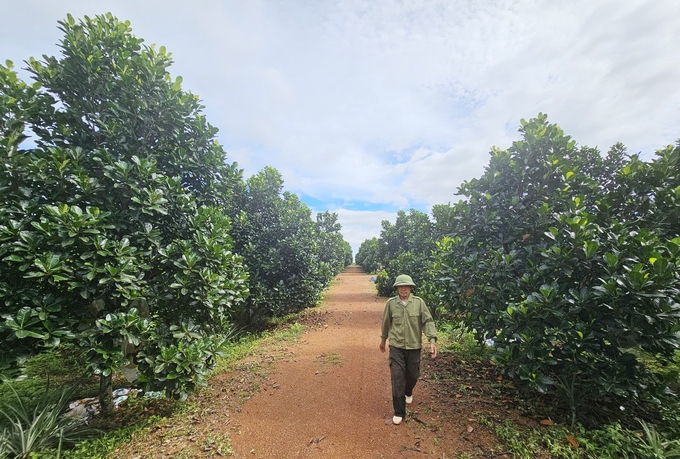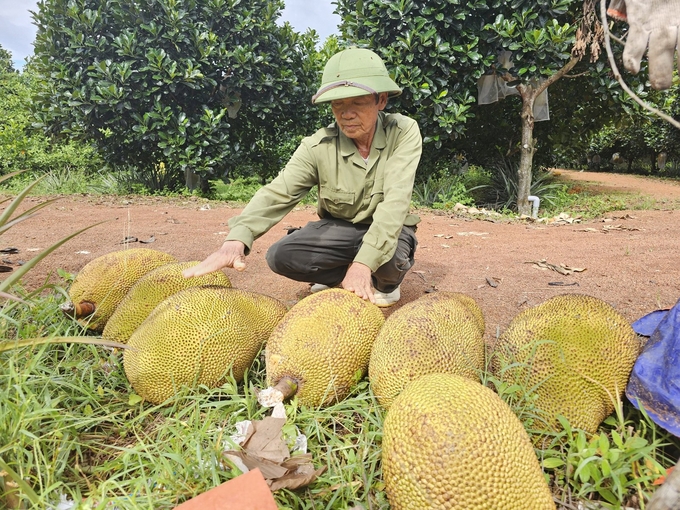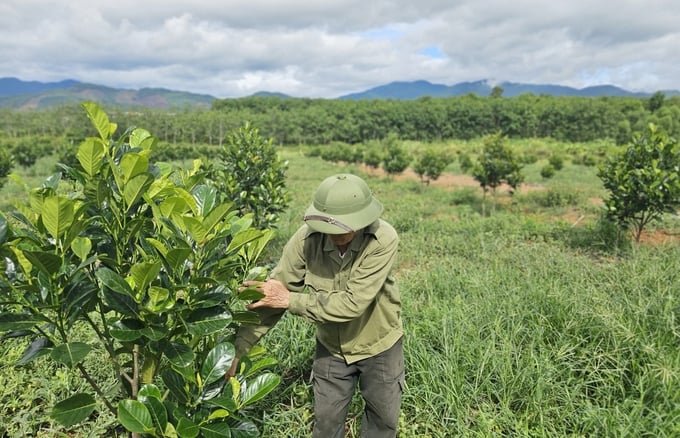November 25, 2025 | 10:51 GMT +7
November 25, 2025 | 10:51 GMT +7
Hotline: 0913.378.918
November 25, 2025 | 10:51 GMT +7
Hotline: 0913.378.918
On the northern side of the hill, Nguyen Van Diem (Huu Nghi residential group, Viet Trung Farm town, Bo Trach district, Quang Binh province) has planted more than 400 red-fleshed jackfruit trees that are nearly a year old. “I cultivate this entire garden of more than 5 ha in an organic manner and do not use pesticides. As for weeds, I only cut them to have them cover the tree roots,” he said.

Diem's red-fleshed jackfruit garden yielded its first main harvest. Photo: Tam Phung.
Nguyen Van Diem’s family used to own a rubber garden of more than 5 ha. After a period of time, the garden was damaged by a big storm and the price of rubber latex dropped. He switched to growing other types of trees but only achieved meager results.
A few years ago, Diem coincidently learned about the high economic value of red-fleshed jackfruit, so he studied its cultivation experience and bought the seeds to plant on the hilly land that used to the rubber garden. "What I like most is that the jackfruit is big, the arils are eye-catching red and the flavor is very special, mixed with the aroma of banana oil. After one bite, it sticks to my memory forever," said Diem.
When the trees took root, Diem went to farms to buy chicken manure to compost with fish protein made from marine fish by-products in the appropriate ratio. He refused to use flowering stimulants or pesticides but instead chose biological products to prevent pests.

The big jackfruits weigh 20 kg when harvested. Photo: Tam Phung.
After nearly three years of planting, the trees gave their first fruits. Immediately, the red-fleshed jackfruit was enthusiastically received by consumers because of its delicious flavor, and all the traders ordered it. Diem was excited because he knew he was on the right track, so he had more confidence in the red-fleshed jackfruit tree. By the fourth year, his family's jackfruit garden entered its first main crop.
When the jackfruit on the tree grew to approximately 1 kg in weight, he asked people to use a mesh bag to cover it to limit the penetration of insects. The aim was to make sure that the jackfruit would have a higher quality and appearance when harvested. "The garden has entered the harvest season. The jackfruit on the tree weighs an average of 8 - 12 kg. The following crops will certainly have bigger fruits because the tree is at its peak," he said.

Red-fleshed jackfruit is bought on-site by traders for VND 20,000/kg. Photo: Tam Phung.
Since the beginning of the harvest season, traders in southern provinces such as Tien Giang, Ben Tre, and many more have continuously called Diem to place orders. The garden has sold three batches with a total volume of over 15 tons of high-quality red-fleshed jackfruit.
“Businesses in southern provinces place orders from the garden with a price of VND 20,000/kg. If each jackfruit tree produces 50 kg of fruit on average, it will bring in an income of VND 1 million. I plant 400 trees/ha, so the income will be estimated at VND 400 million, which is not low at all,” said Diem.
The movement of renovating mixed gardens or converting crop structures on the hills in the Viet Trung Farm town is developing strongly at present. In addition to Diem's family, many households here have also boldly converted their crop structures from low-quality, low-value crops to growing red-fleshed jackfruit when they saw how effective it is. The town now has 20 households growing red-fleshed jackfruit with a total area of over 32 ha.

The newly planted jackfruit garden has taken root on the hillside. Photo: Tam Phung.
Tran Thi Nguyet, President of the Farmers' Union of Viet Trung Farm Town, said that currently, some households are producing red-fleshed jackfruit according to VietGAP standards. They are planning to develop OCOP products in the near future.
“We have a roadmap for people to gradually convert and increase the area of red-fleshed jackfruit trees on the hills. We focus on organic farming, aiming not to use pesticides to create a brand for the product. To ensure output, we support farmers in finding markets, implementing production chains with businesses in the southern provinces to stabilize consumption. The aim is to gradually move towards proactively bringing high-quality products to the market.”
Also on the hill next to Diem's garden, Nguyen Van Thanh is also eager to learn and boldly abandoned traditional crops, devoting more than 1 ha of land to growing red-fleshed jackfruit. Receiving guidance from Diem, Thanh followed a farming method that did not use inorganic fertilizers but only composted manure. “My garden has produced the first crop of fruit this season. I send it to Diem's garden to sell to traders, so we have made some decent income,” Thanh said excitedly.
Translated by Samuel Pham

(VAN) Heavy rains make aquatic species more vulnerable to disease. Proactive water management and high-tech systems help farmers prevent outbreaks and protect yields.

(VAN) Greenhouses are shifting production mindsets in Binh Lu commune, enabling farmers to ‘weather the sun and rain’ and secure stable vegetable harvests throughout the year.

(VAN) Green transition is crucial for the Mekong Delta amid climate change and stricter standards, offering a path toward sustainability.

(VAN) Dong Thap promotes agricultural restructuring, forms large specialized farming zones, raises the value of agricultural products and develops toward ecological and high-tech directions.
/2025/11/22/4018-4-213342_747.jpg)
(VAN) The Mekong Delta Agricultural Experts Club has attracted 143 experts and researchers to participate in providing consultancy and contributing initiatives to the development of one million hectares of high-quality rice.

(VAN) Ca Mau’s development of OCOP products opens a path to increasing cooperatives value, helping boost income, expand markets, and affirm collective economy's role.

(VAN) Turning seemingly ordinary coconut shells into unique jewelry and artwork, Nguyen Bang Nhi spreads the value of local culture through her brand, Cocohand.